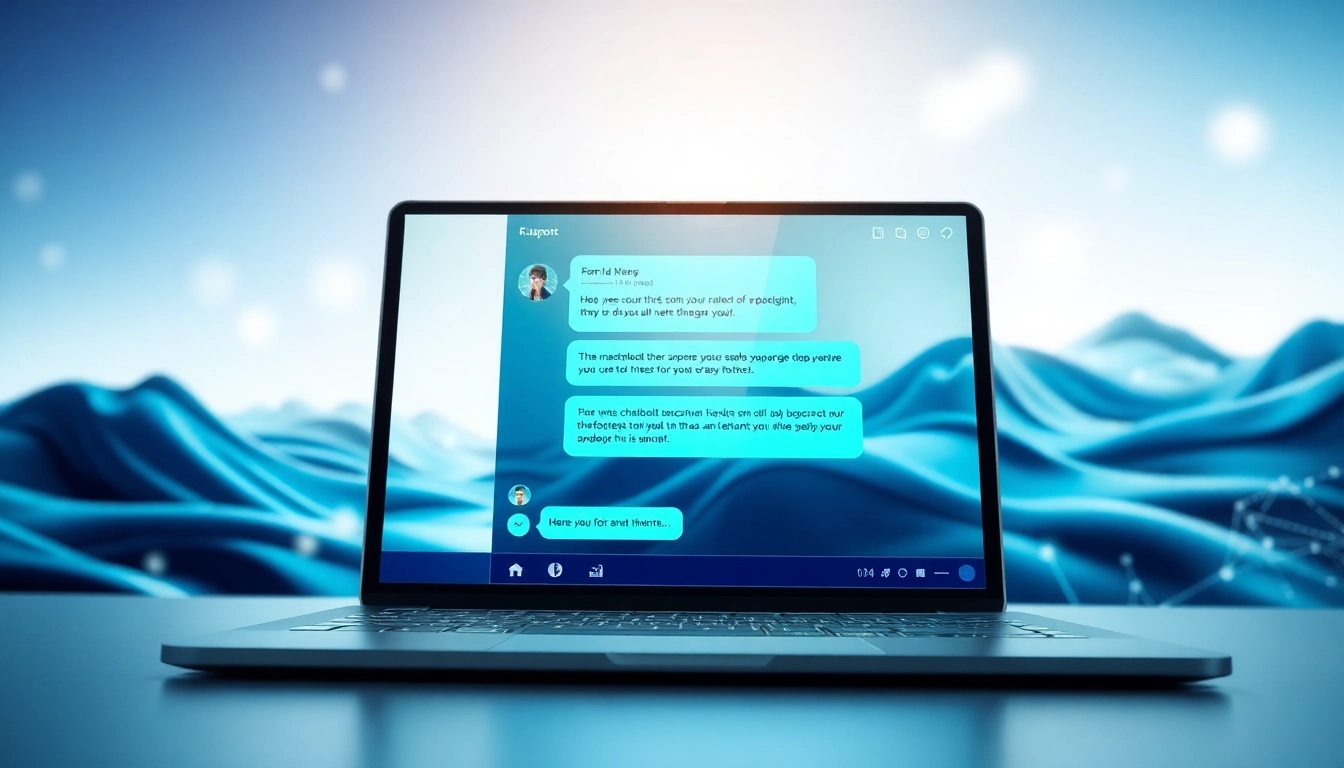Understanding ChatGPT Bots for Websites
What is a ChatGPT Bot?
A ChatGPT bot is an advanced conversational agent that leverages the capabilities of OpenAI’s GPT-3 language model to engage users in real-time conversations on a website. These bots are designed to understand and generate human-like text, allowing them to provide customer support, answer frequently asked questions, and assist users in navigating a website. By implementing a chatgpt bot for website, businesses can enhance user interaction, streamline communication, and create a personalized experience that boosts overall customer satisfaction.
How ChatGPT Bots Work
ChatGPT bots utilize sophisticated natural language processing (NLP) algorithms to analyze user input and generate contextually relevant responses. The process begins when a user interacts with the bot by typing a message. The bot processes this input and generates a response based on a vast dataset it has been trained on, encompassing a diverse range of topics and conversational flows. This ability to learn from previous interactions and adapt responses over time significantly enhances the bot’s effectiveness in addressing user queries.
Benefits of Using a ChatGPT Bot
The integration of a ChatGPT bot into a website offers numerous advantages. Firstly, it provides 24/7 availability, ensuring that user inquiries are addressed promptly, irrespective of the time of day. This round-the-clock service not only improves customer satisfaction but can also lead to higher conversion rates as potential customers receive timely assistance.
Moreover, ChatGPT bots can handle multiple inquiries simultaneously, reducing wait times and freeing human agents to focus on more complex issues. This ability to scale support during peak hours contributes to a more efficient workflow. Additionally, the bot can continuously gather data on user interactions, providing insights that can further enhance the bot’s capabilities and overall user experience.
Implementing a ChatGPT Bot on Your Website
Choosing the Right Platform
When considering the implementation of a ChatGPT bot, selecting the right platform is crucial for seamless integration and optimal performance. Various platforms offer different capabilities, from simple integration tools to more robust solutions that provide customization and advanced analytics.
Factors to consider when choosing a platform include ease of installation, compatibility with existing website frameworks, support options, and the level of customization available. Popular options include platforms like Chatbot, Landbot, and Tidio, which offer various features suited to different business needs.
Step-by-Step Installation Guide
Once a platform has been selected, the installation process can typically be completed in a few straightforward steps:
- Create an Account: Sign up for an account on the chosen platform.
- Choose a Bot Template: Select from various templates that match your business requirements or create a custom bot from scratch.
- Configure Settings: Set parameters such as language, tone of voice, and bot personality to reflect your brand’s identity.
- Integrate with Your Website: Follow the platform’s instructions to embed the bot widget into your website, which often requires copying and pasting code snippets into your HTML.
- Test the Bot: Conduct thorough testing to ensure that the bot responds appropriately to different inquiries and scenarios before going live.
Customizing Your ChatGPT Bot Experience
Customization is vital for ensuring that the ChatGPT bot aligns with your business goals and user expectations. Start by defining the main objectives of your bot: Will it primarily assist with customer service, provide product recommendations, or engage visitors with marketing content? Based on these objectives, you can tailor its conversational flow, response styles, and knowledge base.
Additionally, consider incorporating unique features such as user-specific responses based on past interactions, integrating multimedia content such as images or videos within the chat, and providing quick reply buttons to streamline the conversation. Regularly updating the content and functionalities of your bot will keep it relevant and engaging.
Enhancing User Engagement with ChatGPT Bots
Designing Interactive Conversations
To maximize user engagement, it’s essential to design the ChatGPT bot’s conversations to be interactive and user-friendly. Use open-ended questions that encourage users to express their thoughts, rather than simply providing yes or no answers. Ensure that the bot’s language is friendly, approachable, and aligns with your brand’s voice.
Implementing features like suggested replies or follow-up questions can guide the user experience, helping to maintain a natural flow in the conversation. This design approach not only fosters a sense of connection but also enhances user satisfaction.
Utilizing Data Analytics for Improvements
Monitoring user interactions with the ChatGPT bot is critical in identifying areas for improvement. Many platforms offer built-in analytics that track user engagement metrics, such as response time, user satisfaction ratings, and the most common inquiries. Analyzing this data allows businesses to refine their bot’s responses, update frequently asked questions, and identify any gaps in knowledge.
For deeper insights, consider implementing user feedback loops, where users can rate their experience or suggest improvements for the bot’s functionality. This two-way communication can significantly enhance the bot’s performance and user satisfaction rates.
Integrating with Customer Support Systems
A well-integrated ChatGPT bot can complement existing customer support systems, providing users with instant answers while allowing human agents to manage more complex issues. Consider integrating your ChatGPT bot with customer relationship management (CRM) software or support ticket systems to streamline workflows.
By doing so, the bot can create tickets for unresolved inquiries, pull up user profiles during conversations, or access knowledge bases to deliver accurate information effectively. This seamless integration not only enhances the user experience but also optimizes operational efficiency.
Common Challenges in Using ChatGPT Bots
Addressing User Concerns
While ChatGPT bots can significantly enhance website interactions, they are not without their challenges. One common concern from users is the bot’s inability to understand context or nuances in conversations. This limitation can lead to misunderstandings, frustrating users who expect human-like interaction.
To mitigate this, continually update the bot’s training data and employ techniques like fallback strategies that escalate complex queries to human agents when the bot cannot provide suitable answers. Transparency is also key; informing users about the bot’s capabilities and limitations can set realistic expectations.
Maximizing Performance and Reliability
The performance of a ChatGPT bot can be affected by various factors, such as server load and network connectivity. To ensure reliability, select a robust hosting platform that can handle high traffic volumes, provide regular maintenance, and monitor system health to prevent downtimes.
Additionally, implementing fallback systems — such as routing inquiries to live agents during peak times — can prevent user frustration due to unresponsive bots.
Continuous Training and Updates
As conversational agents evolve, it is essential to regularly train and update the ChatGPT bot to ensure it remains effective. Establishing a feedback loop where insights gained from user interactions inform improvements in the bot’s programming will greatly enhance its functionality.
Regularly updating its knowledge base and adjusting the conversational flow based on real-time data will ensure that the bot stays relevant and provides value to users.
Measuring Success: Key Performance Indicators for ChatGPT Bots
Defining Your Success Metrics
To gauge the effectiveness of a ChatGPT bot, it’s crucial to establish clear success metrics that align with your business goals. Commonly used metrics include user engagement rates, resolution times for customer inquiries, and conversion rates from chat interactions to sales.
Consider tracking Customer Satisfaction (CSAT) scores or Net Promoter Scores (NPS) to assess user sentiment about their interactions with the bot, as these can provide qualitative insights into its impact on the overall customer experience.
Analyzing User Feedback and Engagement
User feedback is invaluable for improving a ChatGPT bot’s capabilities. Implement post-interaction surveys to gather insights about users’ experiences and identify areas that require enhancement. Analyzing engagement metrics, such as session length, return user rate, and drop-off points can also reveal user behavior patterns and preferences.
Regularly reviewing user interactions can help business owners understand common pain points, allowing them to tailor the bot’s functionalities to better meet user needs.
Improving Based on Performance Metrics
Once you have established metrics and collected data, the next step is to utilize this information to inform ongoing improvements. Regular performance reviews can help identify trends, track the impact of adjustments made to the bot, and highlight successful strategies.
By continuously refining the ChatGPT bot based on performance metrics, businesses can ensure it evolves with their audience’s needs, enhancing user experience and driving engagement over time.


